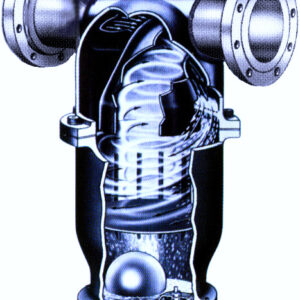Description
What is the minimum velocity required through our separators?
There is no minimum velocity requirement for our separators. Wright-Austin has run many tests over the years that support this contention. There are several characteristics causing separation. When the units are used at or near their maximum capacities, the primary cause for separation is centrifugal force, causing the liquid droplets to move to the outer walls. When the flow is reduced the following characteristics dominate the separation process: Expansion/gravity, Agglomeration and Directional change.
Expansion/Gravity
The air, gas or steam expands in the vessel after leaving the inlet nozzle. This slows down the velocity at which the media and liquid molecules are moving. The liquid droplets tend to bump into each other and form larger droplets. The larger droplets are more likely to fall out due to gravity especially since the speed at which they are moving has also been reduced.
Agglomeration on surface
Droplets that form on the interior surfaces attract (agglomerate) more droplets. Big droplets fall to the bottom and drain out.
Change in Direction: The air, gas or steam flow changes directions (although slowly) inside the vessel in order to exit through the outlet nozzle. A change in flow direction shears off some liquid droplets that cannot make the turn.
All Wright-Austin Model 30L series air liquid separators are available with ASME code stamp in accordance with ASME Section VIII, Division I and CRN.







Reviews
There are no reviews yet.